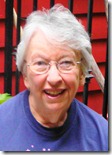 By Sheila Abrams
By Sheila Abrams
It was an unlikely conjunction of images, for me to think of Katniss, the heroine of The Hunger Games, while listening to soloist Agnes Kwasniewska playing Max Bruch’s Violin Concerto with the Baroque Orchestra of New Jersey Sunday. Katniss is characterized as the girl on fire. Kwasniewska, in a totally different realm and a more figurative sense, was a musician on fire.
The concerto, featuring the orchestra’s gifted concert-master, was the centerpiece of a concert under the baton of Maestro Robert W. Butts, at Dolan Hall on the campus of the College of St. Elizabeth in Madison. As Butts frequently does with this orchestra which is now identified as “baroque and beyond,” he spanned centuries of musical history, from the 18th century, with Franz Josef Haydn’s Symphony #42, Mercury, through the 19th century, well-represented by the Bruch work, to the 20th century, with the Symphony #1, Classical, by Sergei Prokofiev.
The Bruch work is a masterpiece of romanticism, a work laced with strong emotion reflecting the period. Bruch was a contemporary of Brahms, Schumann and Tchaikovsky, and this concerto, probably his best-known work, premiered in 1866, around the same time as Brahms’ Requiem.
The European romantic movement, in literature as well as music, was steeped in an idealization of the life of the natural man. The hard life of the peasantry was celebrated as innocent and charming. In music, this took the form of a love for folk music and the melodies of “the common man.” Bruch incorporated Gypsy melodies and, strangely, Jewish folk themes into the Violin Concerto, especially in the monumentally beautiful final movement, the allegro energico.
An interesting fact is that Bruch, a German Protestant, became interested in the Jewish liturgy, composing a well-known setting for the prayer, Kol Nidre, for cello and piano. Though Bruch was not Jewish, this was enough to get his music banned in Germany during the Nazi era, with the result that a whole generation of Germans, including German musicians, grew up without any knowledge of his wonderful music. This may explain why Max Bruch’s name is not as well-known as some of the other composers of his time.
At any rate, Kwasniewska initiated Sunday’s performance, because she wanted to play the concerto. It was interesting to those of us who have seen her play before, especially as the first violin. My image was of a superb technician, reserved in temperament but expressive in her musical interpretation. I was absolutely amazed by the Agnes Kwasniewska I saw Sunday. Her emotional commitment to the music was dazzling. She was one with the composer. It was an unforgettable performance that brought tears to my eyes. That doesn’t happen very often.
The Haydn was a charming classical piece, almost a textbook on what a symphony is. I am fortunate enough to be attending a lecture series by Dr. Butts on the subject of the symphony, and the Haydn could have been written to demonstrate what theme and variations are. Light and airy, it was a delight.
If the Prokofiev symphony has a flaw, it is that it is over too soon. Running a total of about 15 minutes for the full four movements, it left me wanting more. Dr. Butts helped by having the orchestra repeat the impishly funny third movement, a gavotte: non troppo allegro (a dance tempo, fast but not too fast) as an encore. For my personal taste, we don’t hear enough Prokofiev these days.
Congratulations are in order for Maestro Butts, who has been awarded second place in the American Prize competition for community opera conducting, for the BONJ production of Mozart’s Don Giovanni.